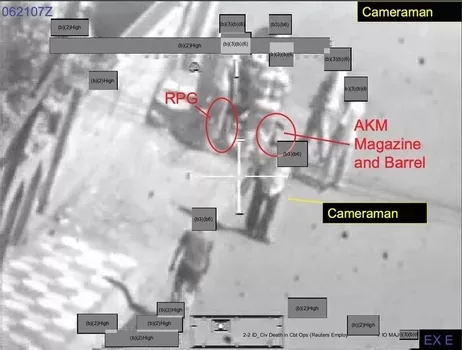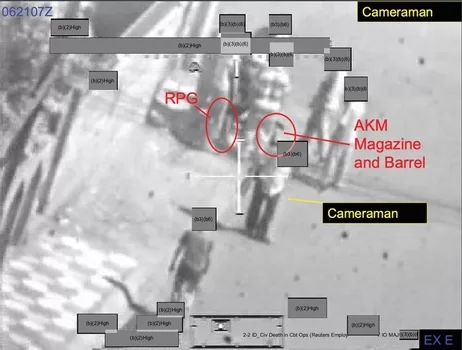How can people play by the rules when only one side makes up the rules, and then they don’t everyone what the rules are?
Reuters and other media organisations covering the war in Iraq had repeatedly asked the US military to see the Rules of Engagement, or be briefed on them, so they knew what conditions their staff were operating in.
Julian Assange discussed the Rules of Engagement because they are the protocols which allow a trigger happy gunner in an attack helicopter to open fire on people. Assange unveiled a serious failing in the military of not briefing the media agencies about the Rules of Engagement, and the chain of command of orders. To date, any investigation by the military into its conduct has been exemplary of itself.
This is Page 6 of our investigation into the death of Reuters cameramen in Iraq and the Wikileaks Collateral Murder leak. The series starts here and covers The General & The CIA Director & Secretary of State.
Andrew Marshall and Alastair Macdonald, two of my predecessors as Reuters Baghdad bureau chief, told me recently that they had for years demanded to see the rules of engagement or be given confidential briefings on them. They were repeatedly rebuffed.
Dean Yates, Reuters bureau chief in Iraq, in Return to Ward 17
Covering a war is a very dangerous occupation. 283 journalists and media workers have been killed in Iraq between 1992 and 2023, according to the Committee to Protect Journalists.
Julian Assange was right to highlight the US Rules of Engagement for Iraq as being a serious issue for the Collateral Murders.
In an Al Jazeera English interview on April 19, 2010, WikiLeaks’ publisher Julian Assange explained why he titled the video Collateral Murder. This quote begins at 12:22 in the interview:
And you can see that they also deliberately target Saaed, a wounded man there on the ground, despite their earlier belief that they didn’t have the rules of engagement — that the rules of engagement did not permit them to kill Saeed when he was wounded.
When he is rescued, suddenly that belief changed. You can see in this particular image he is lying on the ground and the people in the van have been separated, but they still deliberately target him.
This is why we called it Collateral Murder. In the first example maybe it’s collateral exaggeration or incompetence when they strafe the initial gathering, this is recklessness bordering on murder, but you couldn’t say for sure that was murder. But this particular event—this is clearly murder.
Julian Assange said
According to Assange the assault on the van was the most damning piece of video evidence.
“I believe that if those killings were lawful under the rules of engagement, then the rules of engagement are wrong, deeply wrong”
Julian Assange said at the press conference when he released the Collateral Murder video.
What are the Rules of Engagement?
There are a few possible breaches of the Rules of Engagement which may constitute a war crime.
Positive identification – Soldiers must “positively identify” a person whom they intend to kill as a legitimate combatant with “reasonable certainty” that the person is displaying hostile intent. Combatants cannot determine the proportionality of a military response without first positively identifying the combatants involved.
Proportionality – The Law Of Armed Conflict (LOAC), a branch of international law, is the law that States have agreed to accept as binding upon them in their dealings with other States. LOAC says that the concept of proportionality is all military action must be necessary and proportional to a given threat. For example, a tank cannot kill youths who are throwing stones at it.
The Army Counterinsurgency Field Manual states:
“Combatants cannot intend to harm noncombatants, though proportionality permits them to act knowing some noncombatants may be harmed”.
“In policing situations, combatants cannot act in any way in which they know bystanders may be harmed.”
Wounded. The Rules of Engagement and the Law of Armed Conflict do not permit military to shoot at people who are surrendering or who no longer pose a threat because of their injuries.
The Collateral Murder video shows the Apache helicopter firing its 30mm cannon which fires bullets as big as milk bottles into people after they are have either died or are suffering from debilitating wounds.
The Geneva Conventions state that protections must be afforded to people who “collect and care for the wounded, whether friend or foe.” These people should be clearly designated as noncombatants by displaying a red cross or red crescent.
A “positively identified” combatant who provides medical aid to someone amid fighting does not automatically lose his status as a combatant, and may still be legally killed.
Chain of Command
The investigation ordered by General Vincent Brooks did not interview the commanders that the Crazy Horse 1-8 pilot was talking to, or at least did not include such interviews, in their report.
The power to employ deadly force may be vested in an individual not physically present at the battlefield. Therefore, effective communication within the chain of command frequently proves crucial in establishing the circumstances under which soldiers are authorized to open fire. In multiple instances, Apache helicopter crews appear to interpret the on-ground conditions in the most ominous light, despite limited evidence supporting such perceptions.
They communicate to the on-scene commander, “There are five to six individuals with AK-47s,” even when only one or two armed individuals are identified on the street. While the Apache hovers above Saeed Chmargh, injured and grappling on the pavement, the crew expresses optimism that he might discover a weapon, providing them with a legal basis to eliminate him under the Rules of Engagement.
However, upon the arrival of a van, the Apache crew informs the commander, stating, “We have individuals heading to the scene, appearing to possibly pick up bodies and weapons.” Subsequently, this report is revised to a more neutral “picking up the bodies.” Note the significant legal distinctions between these two scenarios.
Later, when seeking authorization to launch a Hellfire missile into a building located on a busy street, Crazy Horse 1-8 informs the commander that there are “at least six individuals in that building with weapons” and that they are linked to a “previous engagement.”
However, conflicting evidence arises when a pair of apparently unarmed men enter the building, suggesting the presence of individuals without weapons. One would anticipate that, in the face of contradictory information, the commander would pause and request additional details before granting approval to demolish a structure in a densely populated area. The deployment of a Hellfire missile typically necessitates a thorough collateral-damage assessment.
Espionage Act of 1917
One of the indictments against Julian Assange and Chelsea Manning concerns the publishing of the US forces Rules of Engagement, which were classified documents.
Ironically, the Espionage Act of 1917, the law under which Assange is indicted, does not define what “classified” documents are – simply because the United States government classification system was not enacted until 1951.
Many of these documents were classified at the Secret level, meaning that their unauthorized disclosure could cause serious damage to United States national security.
Manning also provided rules of engagement files for the Iraq war, most of which were also classified at the Secret level and which delineated the circumstances and limitations under which United States forces would initiate or conduct combat engagement with other forces.
US Dept of Justice indictment against Julian Assange
The Espionage Act of 1917 prohibited obtaining information, recording pictures, or copying descriptions of any information relating to the national defense with intent or reason to believe that the information may be used for the injury of the United States or to the advantage of any foreign nation.
Wikileaks page on Rules of Engagement
This publisher is aware that Assange and Manning have been charged for publishing the US Rules of Engagement. For that reason we have not published them here, in fact, we haven’t even downloaded or read them.
WikiLeaks released the classified Rules of Engagement for 2006, 2007 and 2008, revealing these rules before, during, and after the killings.
- US Rules of Engagement for Iraq, August 2007
- US Rules of Engagement for Iraq, March 2007
- US Rules of Engagement for Iraq, Flowchart 2007
- US Rules of Engagement for Iraq, Refcard 2007
- US Rules of Engagement for Iraq, Refcard 2006
Search Wikileaks for Rules of Engagement, and we found this image for months. For that reason, the Wikileaks page has been mirrored (reprinted in full) below.


The Wikileaks trove of information on military highlights the need for the military to have a better media and public relations briefings system worked out in cooperation with the working press on the ground and elesewhere. You’d think we wouldn’t need to dig around to try and find out the Rules of Engagement between the military and civilians, media and insurgents. It should be front and center on the Military website.
Summary: Classified SECRET consolidated US Forces Rules of Engagement (ROE) for Iraq. Release date: February 4, 2008
On first reading, the document contains a number of items of interest to the press, including rules about mosque attacks, detention of immams, cross border incursions (including Iran and Syria), the use of mines and riot control agents, terrorist targeting, the destruction of Iraqi government property used by insurgents and even kafkaesque rules for attacks on WMD mobile production labs.
Deeper reading by those more familiar with the US-Iraq war is likely to reveal other items of interest, for instance variations in the declaration that Al Quds, the Mahdi Army and armed supporters of Muqtada Al-Sadr are enemies who may be engaged at will.
The document forms a talking point to most US operations in Iraq and the degree of official sanction for them. For example the Jan 10 2008 New York Times article on Blackwater CS gas [tear gas] use: http://www.nytimes.com/2008/01/10/world/middleeast/10blackwater.html
may be compared with this earlier Wikileaks investigation: http://wikileaks.org/wiki/US_violates_chemical_weapons_convention
and Chemical Weapons Convention related rules (Riot Control Agents – RTAs) specified in the Rules of Engagement.
The ROE classification date is 2005-10-03. However ROEs change slowly over time and the current ROE is likely quite similar to the document described here.
The document comes from the same courageous national security whistleblower “Peryton” who disclosed Guantanamo bay’s main manuals and a classified report on Fallujah, all of which were independently verified and released by Wikileaks in December 2007 (U.S lost Fallujah’s info war) and associated links)
A few words on classification and distribution:
“(U)” means unclassified
“(C)” means classified CONFIDENTIAL
“(S)” means classified SECRET
“REL” means “release”
“IRQ” means “IRAQ”
“MCFI” means Multi Coalition Force Iraq
“DISPLAY ONLY TO IRQ” likely means that cleared (to a level of SECRET) Iraqi personnel can only view the document and not retain it.
“FRAGO” means “Fragmentary Order”
“OPORD” means “operating order”.
On legitimacy: The ROE comes from ‘Peryton’ a national security whistleblower who has supplied a number of other classified or For Official Use Only documents, two of which have been publicly verified by the US military: Camp Delta Standard Operating Procedure (2003) & Camp Delta Standard Operating Procedure (2004) and one of which attracted a “no comment”, but was subsequently privately verified by UPI’s national security correspondent Shaun Waterman: U.S lost Fallujah’s info war (and associated links)
Wikileaks has privately verified the ROE and several other documents from this source with our contacts and no document Wikileaks has released from this source has ever been questioned. The material is also in harmony with the public record. We stand by the document.
On motivation, Peryton has shown that they are primarily motivated by ethical concerns and the press has always found something important in their material, e.g: Changes in Guantanamo Bay SOP manual (2003-2004)
Declassification dates are almost always on 10 or 25 year boundaries. SECRET//…/20151003″ (year-month-day) is a standard marking which specifies the declassification date. Simply subtract 10 years to obtain the classification date (2005-10-03).
Analysis
- Cross-border clashes from Iraq O.K.
- US Iraq Rules of Engagement leaked
- Rules stop US entering mosques
- Iraq rules need more airing
- War by the rules in Iraq
- The limits of Individual morality
- Tehran Warns US Forces against Chasing Suspects into Iran
- Spokesman: U.S. forces in Iraq not entitled to chase suspects into Iran
Download File | Torrent | Magnet
Further information United StatesMilitary or intelligence (ruling)US Department of Defense
File size in bytes 108458
File type information PDF document, version 1.4
Cryptographic identity SHA256 92d07937d9570c17af98003eae3541aabdedc6013c1a81552160afa5daa55899
°°°°°
As you can see, it doesn’t take long getting into the Wikileaks data and it becomes overwhelming. The bottom line is we can thank Julian Assange for showing the world that the military has been misbehaving and killing innocent civilians in our name and on our dime. Assange warned us against these wars.
The changes to protocols in the chain of command need to be amended and given to the press photographers and journalists on the ground covering conflicts, or at least regular press briefings.


The military blamed the Reuters cameramen for not wearing PRESS badges and for not letting them know where they were. Communications is a two-way thing and there was a communication breakdown.
Whatever the Rules of Engagement should be an agreement between the press covering the event and those issuing the daily briefings. Its a lot like a Notam, Notice to Airmen is issued daily providing timely and accurate information.
Rules of Engagement – This is Part 5 of our investigation into the death of Reuters cameramen in Iraq and the Wikileaks Collateral Murder leak. The series starts here and covers The General & The CIA Director & Secretary of State.
This background to Julian Assange’s story is part of our investigation into the death of Reuters cameramen in Iraq and the Wikileaks Collateral Murder leak. Our ten page investigation into the death of Reuters camera crew in Iraq.
1 The trial of Julian Assange exposes US Rules of Engagement
2 US Military killed two Reuters photographers in Iraq
3 The fix is in: Military investigation into deaths of Reuters staff in Iraq
4 Generals Brookes & Fox meet the Reuters editors
5 Military ignored FOI requests for video of deaths
6 Rules of Engagement between military & civilians
7 Assange: WikiLeaks release Collateral Murder video
8 Definitions, Resources, Transcripts, Apache details
9 Who, what, when and why of the Assange case
10 Wikileaks Collateral Murder video aftermath. Where are they now?
A quick update on the Julian Assange story






